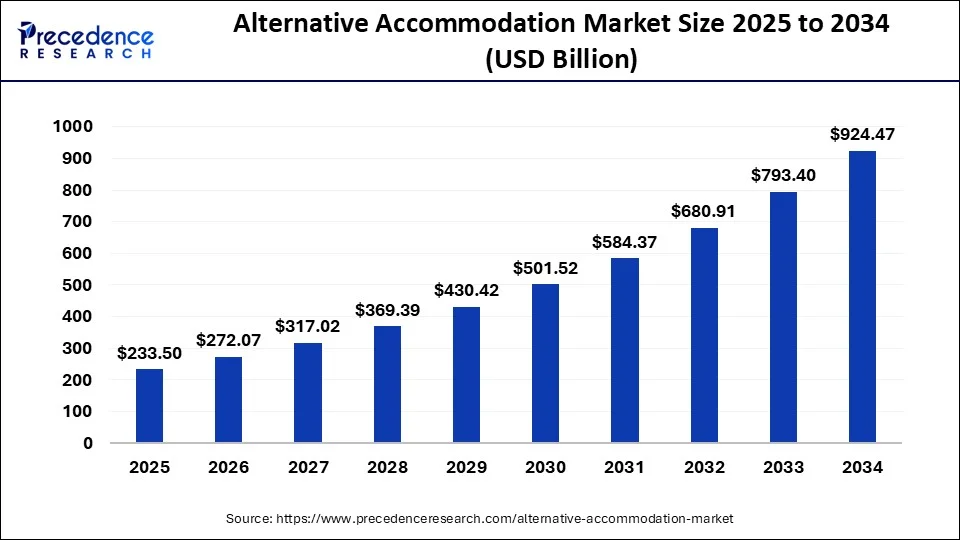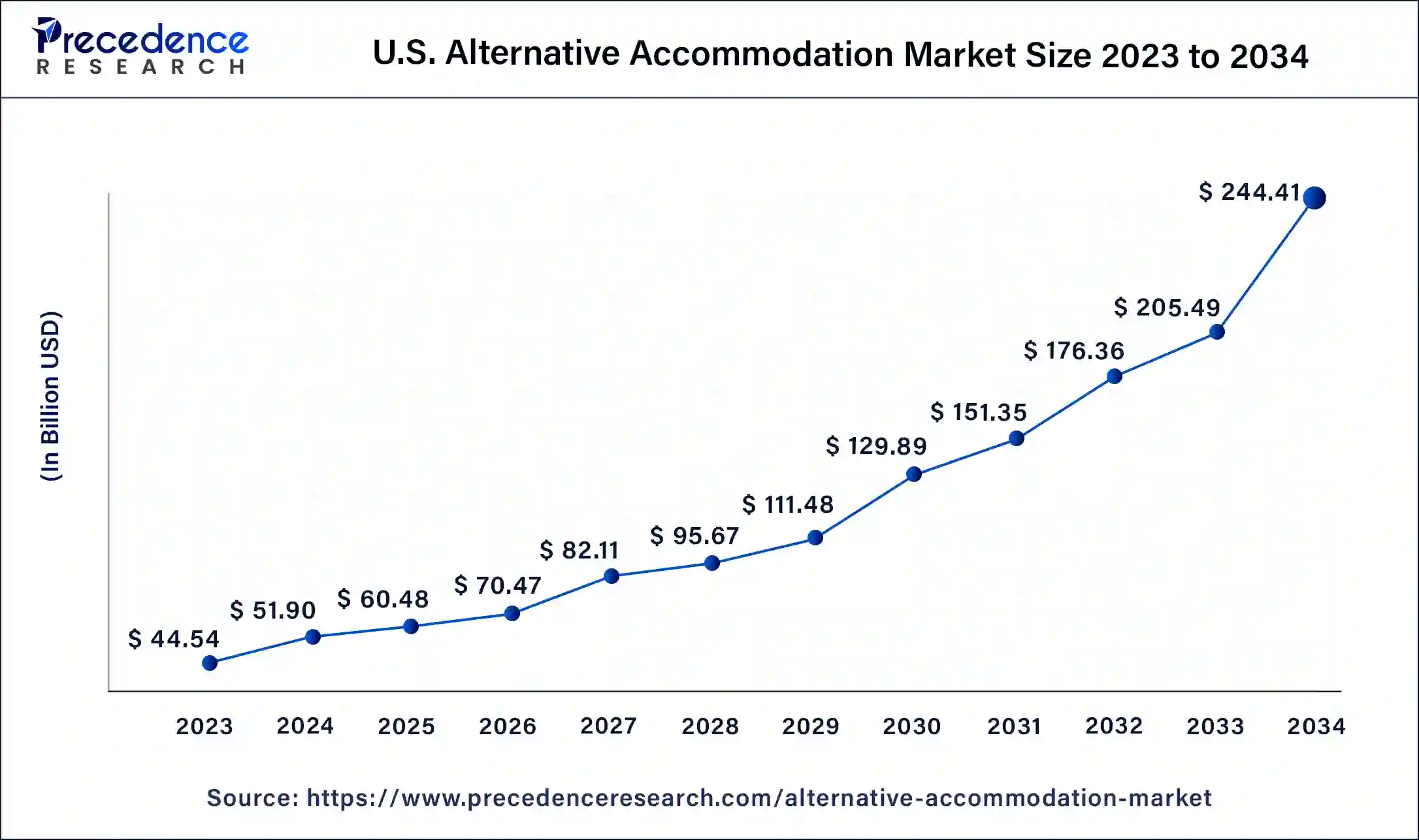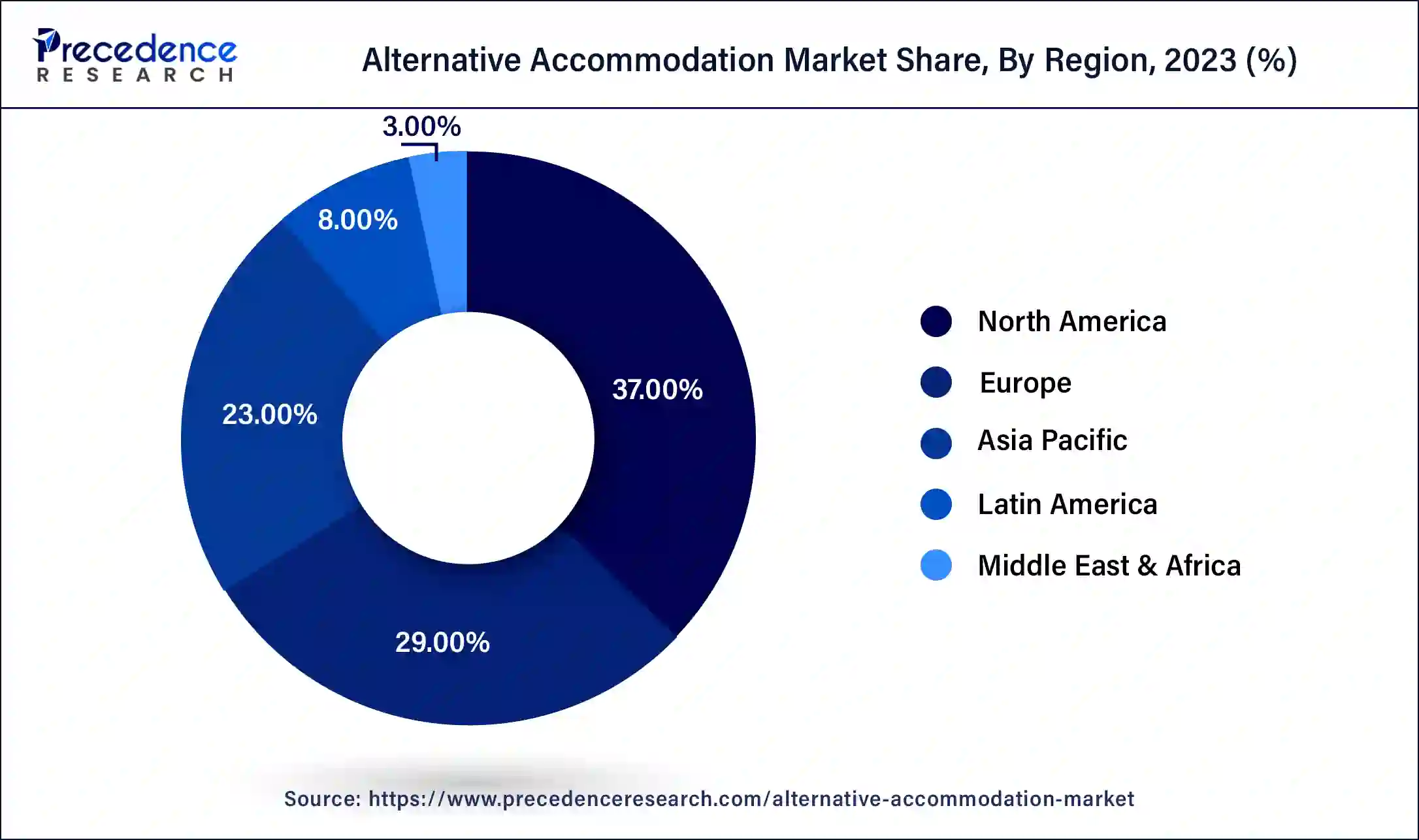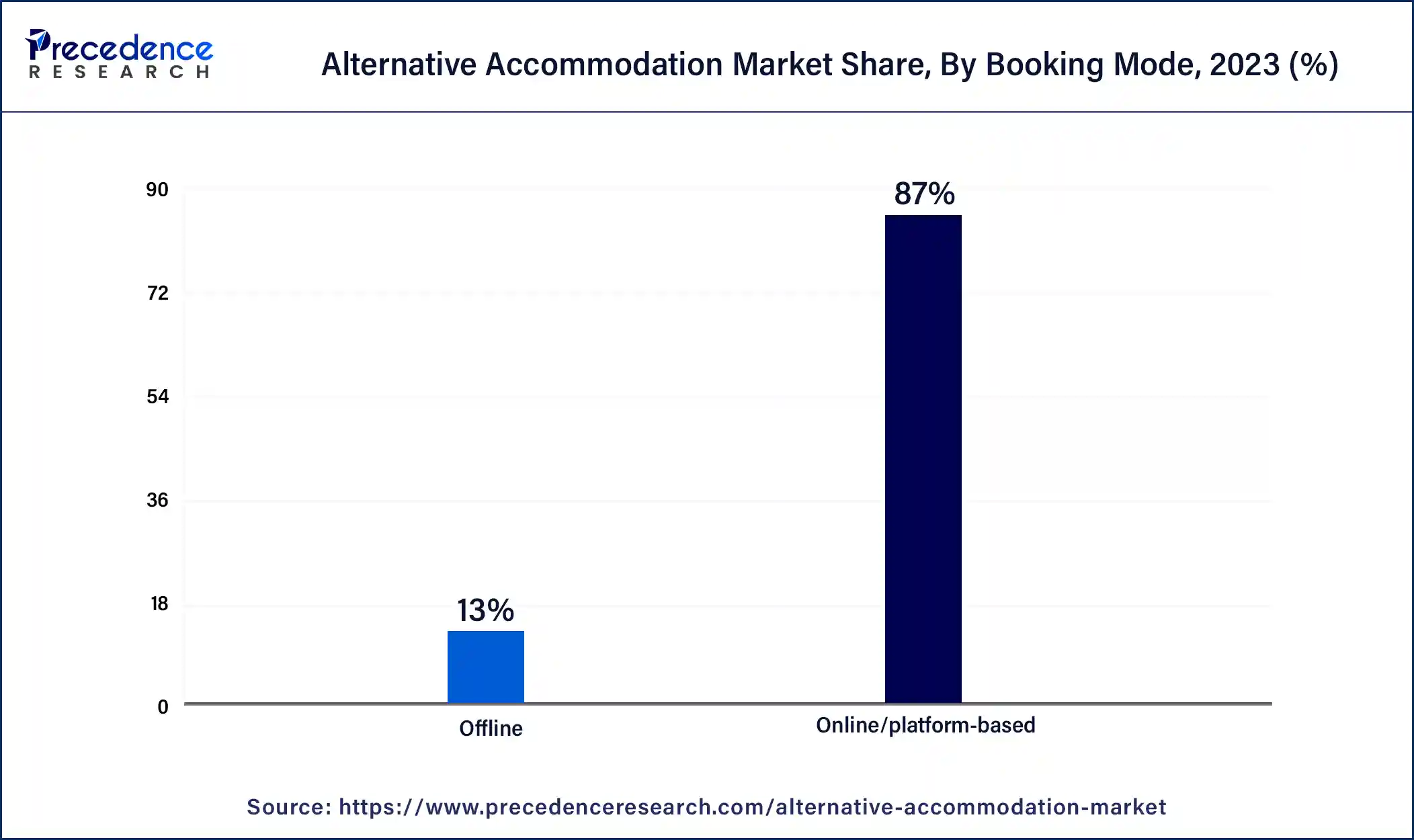List of Contents
Alternative Accommodation Market Size and Forecast 2025 to 2034
The global alternative accommodation market size is predicted to surpass around USD 924.47 billion in 2034 from USD 200.4 billion in 2024, at a CAGR of 16.52% between 2025 and 2034. The global alternative accommodation market is mainly driven by the constantly evolving international tourism sector and comfortable vacation stays.

Alternative Accommodation Market Key Takeaways
- The global alternative accommodation market was valued at USD 200.4 billion in 2024.
- It is projected to reach USD 924.47 billion by 2034.
- The alternative accommodation market is expected to grow at a CAGR of 16.52% from 2025 to 2034.
- North America led the alternative accommodation market with the largest market share of 37% in 2024.
- Asia Pacific is expected to expand at a CAGR of 17.62% over the period studied.
- By accommodation type, the home segment has contributed more than 31% in 2024.
- By accommodation type, the apartments/condominium segment is projected to grow at a fastest CAGR 17.72% during the forecast period.
- By booking mode, the online segment has captured more than 87% of market share in 2024.
- By booking mode, the offline segment is expected to grow at a faster rate in the market over the projected period.
U.S. Alternative Accommodation Market Size and Growth 2025 to 2034
The U.S. alternative accommodation market size was exhibited at USD 51.90 billion in 2024 and is projected to be worth around USD 244.41 billion by 2034, poised to grow at a CAGR of 16.76% from 2025 to 2034.

The alternative accommodation market was dominated by North America. Business travelers in this region are increasingly turning to alternative accommodations for extended stays or when traditional hotels are limited, which is creating new opportunities for companies in this sector. The region's higher spending on booking condominiums and homes, along with advanced technological infrastructure in countries like the U.S. and Canada, is expected to further accelerate market growth.
- In November 2022, Marriott International announced the expansion of its existing portfolio of serviced apartments with the introduction of ‘Apartments by Marriott Bonvoy' in Canada & United States. With the launch of Apartments by Marriott Bonvoy, customers or guests will be able to easily shop a wider range of accommodation options within the company portfolio and meet the company's desire to provide premium accommodations that offer home-like amenities.

Asia Pacific will experience the fastest growth in the alternative accommodation market over the period studied. This expansion is primarily driven by increasing consumer spending on staycations and travel. Governments in countries such as India, China, Vietnam, and Australia are actively promoting tourism to boost overall regional growth by creating infrastructure and jobs. The demand for alternative accommodation is also rising due to tourists becoming more aware of these rental options.
The Asia Pacific alternative accommodation marketis projected to grow in the coming years. Increased government initiatives in countries like India, Indonesia, China, and Vietnam are aimed at expanding the tourism industry to generate income and create new jobs. Additionally, heightened awareness about the availability of holiday rentals is contributing to the strong growth of the region.
- In May 2022, leading online travel services firm MakeMyTrip said it had witnessed a nearly 150 percent increase in bookings for super-luxury and premium hotels during the pandemic compared to the pre-pandemic period, as more Indian travelers seek elite travel experiences.
Market Overview
Alternative accommodation encompasses all types of lodging outside the formal or organized accommodation sector. This form of lodging differs from what is typically recognized as tourist accommodation, which presents a distinct alternative. It is also regarded as sustainable since it does not require a high concentration of resources or infrastructure and can be repurposed if tourism ceases to be a primary activity.
Accommodation types can be categorized into two groups: catered and non-catered. Catered accommodation includes food provisions for tourists, which may or may not be included in the overall price of the lodging. Catering services come in various forms, sizes, and quantities. Whereas not catering accommodations do not include food provisions.
Alternative Accommodation Market Growth Factors
- The rise of online travel booking agencies along with the growth of the hotel industry globally is expected to fuel the alternative accommodation market growth soon.
- key players operating in the industry are constantly focusing on numerous business tactics that can drive the alternative accommodation market growth during the forecast period.
- Technological advancement in the traveling sector can drive the market growth further.
- Rising inclination towards exploring newer places will likely contribute to the expansion of the alternative accommodation market.
Market Scope
| Report Coverage | Details |
| Market Size by 2034 | USD 924.47 Billion |
| Market Size in 2025 | USD 233.50 Billion |
| Market Size in 2024 | USD 200.40 Billion |
| Market Growth Rate from 2025 to 2034 | CAGR of 16.52% |
| Largest Market | North America |
| Base Year | 2024 |
| Forecast Period | 2025 to 2034 |
| Segments Covered | Accommodation Type, Booking Mode, and Regions |
| Regions Covered | North America, Europe, Asia-Pacific, Latin America, and Middle East & Africa |
Market Dynamics
Driver
Increasing consumer spending power
The rapid increase in consumer spending on tourism-related activities and the growing popularity of travel for various reasons, such as leisure, holidays, and business, are major factors driving the demand and growth of the global alternative accommodation market. Moreover, the continuous rise in internet usage worldwide and the convenience of booking hotels or alternative accommodations online significantly contribute to this growth. These factors help travelers easily find and understand their desired destinations, further fostering market expansion.
- In April 2024, luxury hotel brand World of One launched an alternative to larger associations such as Relais and Chateaux and Small Luxury Hotels of the World. Founded by Patrice Van Isacker, World of One launched 22 independent hotels in the portfolio and is set to raise the visibility of idyllic retreats, such as Rosyth Estate House in Sri Lanka and Asty Mykonos in Greece.
Restraint
Safety security and lack of basic amenities
A major challenge for the alternative accommodation market is safety. The host has the potential to improve a traveler's stay but can also make it unpleasant. They might interfere or cause discomfort to the customer. The host's right to cancel the stay and the lack of direct interaction between the booking platform (company) and the customer contributes to a sense of insecurity. Additionally, a downside of this budget-friendly option is the risk of non-disclosure. The absence of details about basic amenities, which may be considered obvious, can lead to significant discomfort for the customer.
Opportunity
Investment in alternative accommodation
Hotel companies are keen to diversify their portfolios by entering the alternative accommodation sector on a global scale. Since the COVID-19 pandemic, consumer preferences have shifted due to the flexibility to work or live from anywhere, with many seeking short-term rentals for extended stays. This shift in preferences is anticipated to accelerate growth and create lucrative opportunities for the alternative accommodation market players.
- In January 2024, Choice Hotels International, Inc. launched its newest multichannel national marketing campaign, ‘A Stay for Any You.' The largest in Choice Hotels' history, the campaign includes actor and writer Keegan-Michael Key in national TV and streaming TV ads and social media content. The campaign shows some of the reasons people travel and how Choice can meet their needs.
Accommodation Type Insights
The home segment dominated the alternative accommodation market in 2024. The segment's growth is attributed to the rising popularity of homestays among both domestic and international travelers, thanks to the comfort, safety, and privacy they provide. Moreover, the affordability and pet-friendly environment of home-based vacation rentals attract travelers worldwide. Consumers are increasingly opting for home vacation rentals as they are less expensive than hotels while offering similar amenities. This trend is expected to contribute positively to the global market's growth.
The apartments/condominium segment is expected to experience the fastest growth in the alternative accommodation market during the forecast period. Staying in apartments or condominiums allows travelers to immerse themselves in the local culture and experience life as a resident rather than a tourist. This is expected to significantly drive market growth. Additionally, the increasing popularity of these accommodation types among millennials and business travelers is the main driving force due to the various luxury amenities such as sports clubs, swimming pools, and clubhouses.
Booking Mode Insights
The online segment led the global alternative accommodation market in 2024. The primary factor driving the segment's growth is the increasing use of mobile phones. The rise in Internet usage has facilitated hotel bookings through online channels, which makes the process easy, simple, and convenient. Furthermore, online channels provide features such as straightforward payments, hassle-free bookings, secure payment options, and free cancellations, which attract more customers. Recently, consumers have increasingly favored online booking platforms for these features, further boosting the demand for online booking channels.
- In February 2023, booking .com, an online hotel booking platform, has looked to expand vacation. A beach house, a treehouse, a tiny home. Actress Melissa McCarthy makes references to all these vacation rental properties in Booking. Com's Super Bowl commercial is an intentional move for a brand that is delving further into the alternative accommodation space.

The offline segment is expected to grow at a faster rate in the alternative accommodation market over the projected period. The growth is largely attributed to Gen X and baby boomers, who constitute the primary consumer base. Globally, many consumers continue to prefer offline booking methods due to the ability to inspect and review the place before making a reservation.
Moreover, travelers seek flexibility and a high-quality customer experience when booking through offline channels, which contributes to this mode's growth. However, as internet and smartphone usage rise among consumers, preferences are expected to shift towards online booking. The emergence of online travel booking channels is anticipated to disrupt the industry in the coming years.
Alternative Accommodation Market Companies
- Airbnb Inc.
- Agoda Homes
- Booking.com.
- HomeToGo
- Expedia Group
- FlipKey
- holidu.co.uk.
- HomeAway
- MakeMyTrip Limited
- Onefinestay
- Peakah
- Plum Guide
- Stay Alfred
- Sonder
- Trip.com Group Limited
- TripAdvisor Inc.
- Wyndham Destinations Inc.
- Wimdu
Recent Developments
- In April 2023, the adventure travel marketplace TourRadar published its first Climate Action Plan, which urges all 2,500 tour operators to implement sustainability activities by 2030 and provide a carbon footprint monitoring tool.
- In April 2022, Airbnb partnered with Visit North Carolina to promote travel to 16 rural counties with an extensive focus on unique stays, charming experiences, and local attractions. This strategic initiative is aimed at supporting the regional post-pandemic recovery for restaurants, workers, and many unique local shops that rely on the local tourism industry.
- In December 2022, the Best Western Plus hotels in Lawrence, Kansas, and Norman, Oklahoma, owned by Wichita, Kansas-based Hospitality Management LLC, changed brands and are now run as StoneHill, Trademark Collection by Wyndham.
- In May 2022, online travel firm MakeMyTrip partnered with 15 banks, NBFCs, and fintech players, including HDFC Bank, IDFC Bank, Capital float, and Zest Money, for its 'book now pay later option while booking flights or hotels.
Segments Covered in the Report
By Accommodation Type
- Home
- Apartments/Condominium
- Alternative Accommodation & Camping
- Hostel
- Others
By Booking Mode
- Online/Platform-based
- Offline
By Geography
- North America
- Asia Pacific
- Europe
- Latin America
- Middle East & Africa
For inquiries regarding discounts, bulk purchases, or customization requests, please contact us at sales@precedenceresearch.com
Frequently Asked Questions
Ask For Sample
No cookie-cutter, only authentic analysis – take the 1st step to become a Precedence Research client